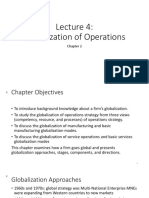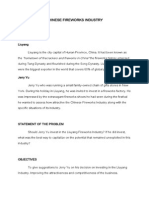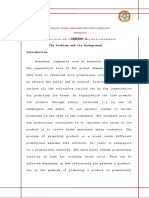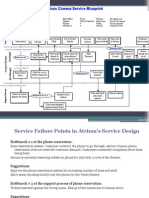Services Chapter 5
Services Chapter 5
Uploaded by
Amanda SamarasCopyright:
Available Formats
Services Chapter 5
Services Chapter 5
Uploaded by
Amanda SamarasOriginal Description:
Copyright
Available Formats
Share this document
Did you find this document useful?
Is this content inappropriate?
Copyright:
Available Formats
Services Chapter 5
Services Chapter 5
Uploaded by
Amanda SamarasCopyright:
Available Formats
Chapter 5
The Service Delivery Process
Stages of Operational Competitiveness
Philosophical viewpoint where operations move from necessary evil to the key source of competitive advantage.
Four Stages of Operational Competitiveness
Stage
1: Available for Service
operations are a necessary evil operations are reactive the primary mission is to avoid mistakes technological investment, training, and personnel costs are minimize management designs skill out of the work
Four Stages of Operational Competitiveness
Stage
2: Journeyman
prompted by the arrival of competition operations become outward-looking investment in technology is linked to long-term costs savings processes are developed, implemented, and monitored operations still viewed as a secondary function
Four Stages of Operational Competitiveness
Stage
the
3: Distinctive Competencies Achieved
firm has mastered the core service understands complexity of making changes operations are now viewed equal with other departments view of technology changes from cost savings to enhancing the customers experience
Four Stages of Operational Competitiveness
Stage
4: World Class Service Delivery
companys name is synonymous with service excellence become a fast learner and innovator
technology
provides a means to accomplish tasks that the competition cannot duplicate
Marketing and Operations: Balance is Critical
The marriage of customer needs with the manufacturing and technological capabilities of the firm The marriage involves compromise
customer needs can seldom be met completely and economically
Success in service marketing demands a much greater understanding of the constraints and opportunities posed by operations
Thompsons Perfect-World Model
Perfect-World
Model
To operate efficiently, a firm must be able to operate as if the market will absorb the single kind of product at a continuous rate and as if the inputs flowed continuously at a steady rate and with specified quality
The Focused-Factory Concept
An
operation that concentrates on performing one particular task in one particular part of the plant for promoting experience and effectiveness through repetition and concentration on one task necessary for success
Used
10
The Plant within a Plant Concept
PWP
An
Concept
operation that that breaks up large, unfocused plants into smaller units buffered from one another so that they can each be focused separately buffer environmental influences by surrounding their technical core with input and output components
Organizations
11
Applying Efficiency Models to Services
Servuction
system is an operations nightmare impossible to use inventories problems with decoupling production from the customer system is directly linked to the market
demand
varies day to day, hour to hour, minute to
minute
massive
problems in capacity planning and utilization
Possible Solutions to Service Operation Problems
1.
12
Isolate the technical core
Different
management philosophies should be adopted for each unit of operation technical core should be subjected to production-ling approaches high contact areas should sacrifice efficiency in the interest of the consumer
13
Possible Solutions to Service Operation Problems
2. 3. 4. 5.
Production-lining the whole system Creating flexible capacity Increasing customer participation Moving the time of demand
14
Service Blueprints
Blueprints
provide a means of communication between operations and marketing and can highlight potential problems on paper before they occur.
essentially a flowchart that shows lines visibility
Figure 5.3 Blueprint for Cafeteria-Style Restaurant
15
16
Components of a Service Blueprint
Identify direction in which processes flow Identify the time it takes to move from one process to the next Identify the costs involved with each process step Identify the amount of inventory build-up at each step Identify the bottlenecks in the system
17
Blueprinting and New- Product Development
Complexity--the number and intricacy of steps
Specialization strategy
decreases
by
Penetration strategy
increases
by
reducing the number of steps in the process it unbundles the service offering increasing the number of steps
complexity
complexity
18
Blueprinting and New- Product Development
Divergence--degrees of freedom in decision making
Volume-oriented strategy (production-line)
decreases
produces
Niche
costs but does so at the expense of increasing conformity and inflexibility
standardized output and reduces
divergence
increases
Tailor
positioning strategy
divergence
the service experience to each customer
You might also like
- Mapping Experiences - A Complete Guide To Creating Value Through Journeys, Blueprints, and Diagrams - Jim KalbachDocument42 pagesMapping Experiences - A Complete Guide To Creating Value Through Journeys, Blueprints, and Diagrams - Jim KalbachLuiza FonsecaNo ratings yet
- Strama-2 Dunkin CaseDocument12 pagesStrama-2 Dunkin CaseGemma Malasador IgnacioNo ratings yet
- This Study Resource Was: Chapter 12 Buying Merchandise (30 PTS) Ch12-1. (5 PTS)Document6 pagesThis Study Resource Was: Chapter 12 Buying Merchandise (30 PTS) Ch12-1. (5 PTS)Tú QuyênNo ratings yet
- Huawei ReportDocument16 pagesHuawei Reportshady emadNo ratings yet
- Case Study On UnileverDocument4 pagesCase Study On UnilevermonikaNo ratings yet
- Theory-Channel Design Decisions+ Nestle CaseDocument25 pagesTheory-Channel Design Decisions+ Nestle CaseSmitesh VaidyaNo ratings yet
- Quijano Philippine Seven Corp Entre 7 Submission 2Document5 pagesQuijano Philippine Seven Corp Entre 7 Submission 2Nadya Quijano100% (1)
- Group 7 Final Strategy Paper - Maycar Foods Inc.Document34 pagesGroup 7 Final Strategy Paper - Maycar Foods Inc.Mig SablayNo ratings yet
- Case No. 1 - Smart Style SalonDocument8 pagesCase No. 1 - Smart Style SalonMarie Rose Jasmine ChanNo ratings yet
- CPM and Porters 5 ForcesDocument10 pagesCPM and Porters 5 ForcesGeloApostolNo ratings yet
- Service BlueprintDocument12 pagesService BlueprintV Shylaja ShylajaNo ratings yet
- Diseño de Blueprint Integrando Servicios On Line y Off Line ClaveDocument11 pagesDiseño de Blueprint Integrando Servicios On Line y Off Line ClaveLuisa RaigozoNo ratings yet
- Solved 1 Create A Service Blueprint of The Refinancing Process WhyDocument1 pageSolved 1 Create A Service Blueprint of The Refinancing Process WhyDoreenNo ratings yet
- Designing Customer Experience Using DFSS (Handout)Document15 pagesDesigning Customer Experience Using DFSS (Handout)Dennis T. Beng HuiNo ratings yet
- Manila Bulletin Publishing Corporation Sec Form 17a 2018Document128 pagesManila Bulletin Publishing Corporation Sec Form 17a 2018Kathryn SantosNo ratings yet
- Madfund Case Analysis #2 (Smell Chic)Document12 pagesMadfund Case Analysis #2 (Smell Chic)Russ FajardoNo ratings yet
- PrimablendDocument7 pagesPrimablendZia Irra AlegreNo ratings yet
- Vista LandDocument2 pagesVista LandDPS1911No ratings yet
- Market Case StudyDocument3 pagesMarket Case StudyJoshua PedayoNo ratings yet
- CaseDocument12 pagesCaseShankar ChaudharyNo ratings yet
- Strama 1 QuizDocument3 pagesStrama 1 QuizMark Roger II HuberitNo ratings yet
- Tri-R and Gardenia Reaction PaperDocument7 pagesTri-R and Gardenia Reaction PaperKatrina LeonardoNo ratings yet
- Intuit Inc SwotDocument2 pagesIntuit Inc SwotEngr Gaddafi Kabiru MarafaNo ratings yet
- Shell Ems - EditedDocument14 pagesShell Ems - EditedGeovanie LauraNo ratings yet
- Assessment 3 (Dominos Case Study)Document5 pagesAssessment 3 (Dominos Case Study)RishabNo ratings yet
- IPLC TheoryDocument10 pagesIPLC Theoryreshma1428No ratings yet
- StrengthDocument2 pagesStrengthKaiden AmaruNo ratings yet
- Chapter 8 NoteDocument10 pagesChapter 8 NoteKollol RozarioNo ratings yet
- Angel's Pizza Pro Forma Income Statement January 2019 - December 2019Document5 pagesAngel's Pizza Pro Forma Income Statement January 2019 - December 2019Rimar LuayNo ratings yet
- Lecture Sales and Distribution Management - Chapter 13 - Krishna K Havaldar, Vasant M Cavale - 1199696Document31 pagesLecture Sales and Distribution Management - Chapter 13 - Krishna K Havaldar, Vasant M Cavale - 1199696sistla.suneethaNo ratings yet
- UNIT V Marketing Organization and ControlDocument19 pagesUNIT V Marketing Organization and ControlVinay VinnuNo ratings yet
- Cost LeadershipDocument12 pagesCost LeadershipMichelle Chong Xui IngNo ratings yet
- Managing Change and Innovation: Stephen P. Robbins Mary CoulterDocument31 pagesManaging Change and Innovation: Stephen P. Robbins Mary CoulterRatul HasanNo ratings yet
- Step To Building The Supply BaseDocument3 pagesStep To Building The Supply BaseAri KaNo ratings yet
- Mission AnalysisDocument9 pagesMission AnalysisTasin NasirNo ratings yet
- Primary Selective Demand StrategiesDocument43 pagesPrimary Selective Demand Strategiesjeddy0140% (1)
- Gutierrez B (2003) - AndecDocument13 pagesGutierrez B (2003) - AndecPunch ButtfaceyNo ratings yet
- Analysis Communication Process in McdonaldsDocument3 pagesAnalysis Communication Process in McdonaldsEditor IJTSRD0% (1)
- XeroxDocument6 pagesXeroxirinaestefania100% (1)
- CH 12Document49 pagesCH 12Natasya SherllyanaNo ratings yet
- Political Economic Social: Distributing Goods and ServicesDocument2 pagesPolitical Economic Social: Distributing Goods and ServicesKyrah Angelica DionglayNo ratings yet
- Petron For AccountingDocument8 pagesPetron For Accountingcarlo_sinlao100% (1)
- AP Cargo CI ProjectDocument56 pagesAP Cargo CI ProjectRhoel YadaoNo ratings yet
- SMART Application FormDocument1 pageSMART Application FormjeriesalvadorNo ratings yet
- Lecture 4 Globalization of OperationsDocument28 pagesLecture 4 Globalization of OperationsmalakNo ratings yet
- Mang Inasal: Submitted byDocument43 pagesMang Inasal: Submitted byLeonardo Jr SaldivarNo ratings yet
- THE HOUSE OF NUTS FEASIB Revision Part 1Document49 pagesTHE HOUSE OF NUTS FEASIB Revision Part 1Jean Diane JoveloNo ratings yet
- SME Roving Academy Operations Manual PDFDocument29 pagesSME Roving Academy Operations Manual PDFMa Cecile Candida Yabao-RuedaNo ratings yet
- ACCO 20293 - Module 1 - Intro To Management AcctgDocument9 pagesACCO 20293 - Module 1 - Intro To Management AcctgAeram Justine PeñaflorNo ratings yet
- Operation S Strategy in Global ArenaDocument15 pagesOperation S Strategy in Global ArenaMiljane Perdizo100% (1)
- Petron CorporationDocument16 pagesPetron CorporationzaineNo ratings yet
- Case 6Document4 pagesCase 6Christian King IlardeNo ratings yet
- Module 3 - Evaluating Channel MembersDocument19 pagesModule 3 - Evaluating Channel MembersRito RaxoNo ratings yet
- Strategic Management Chapter 5Document18 pagesStrategic Management Chapter 5PIOLA CAPINA100% (1)
- BMC Module 5 Revenue Streams and Key Resources - CompressedDocument5 pagesBMC Module 5 Revenue Streams and Key Resources - CompressedOlaiya EphraimNo ratings yet
- EntrepreneurshipDocument10 pagesEntrepreneurshipCherelyn MaglasangNo ratings yet
- 06 Task Performance 1Document5 pages06 Task Performance 1Daniela de LeonNo ratings yet
- Procter & Gamble: Company's ProfileDocument4 pagesProcter & Gamble: Company's ProfileMadiha KhanNo ratings yet
- Chinese Fireworks IndustryDocument3 pagesChinese Fireworks IndustryAnjerīn David0% (1)
- QSasDocument50 pagesQSasArvin Delos ReyesNo ratings yet
- Case Study (Motorola)Document3 pagesCase Study (Motorola)Carmela Emma Pascual Garcia100% (1)
- Gardenia Reaction PaperDocument1 pageGardenia Reaction PaperAnne ElamparoNo ratings yet
- Supply Chain NestleDocument9 pagesSupply Chain NestleJames EdlynNo ratings yet
- Value Chain Management Capability A Complete Guide - 2020 EditionFrom EverandValue Chain Management Capability A Complete Guide - 2020 EditionNo ratings yet
- Chapter 5Document22 pagesChapter 5Janinne BianesNo ratings yet
- Chapter 10 Survey Research - Communicating With RespondentsDocument29 pagesChapter 10 Survey Research - Communicating With RespondentsAmanda Samaras100% (1)
- Chapter 11 Observation ResearchDocument16 pagesChapter 11 Observation ResearchAmanda Samaras100% (1)
- Chapter 12 Experimental ResearchDocument43 pagesChapter 12 Experimental ResearchAmanda SamarasNo ratings yet
- Chapter 8 Secondary Data ResearchDocument23 pagesChapter 8 Secondary Data ResearchAmanda Samaras100% (1)
- Chapter 7 Qualitative Research ToolsDocument35 pagesChapter 7 Qualitative Research ToolsAmanda Samaras100% (1)
- Services Chapter 2Document20 pagesServices Chapter 2Amanda SamarasNo ratings yet
- Chapter 5 Human Side of Research - Ethical IssuesDocument31 pagesChapter 5 Human Side of Research - Ethical IssuesAmanda SamarasNo ratings yet
- Chapter 3 Theory BuildingDocument13 pagesChapter 3 Theory BuildingAmanda SamarasNo ratings yet
- Chapter 4 The Business Research ProcessDocument30 pagesChapter 4 The Business Research ProcessAmanda SamarasNo ratings yet
- Chapter 1 The Role of Business ResearchDocument15 pagesChapter 1 The Role of Business ResearchAmanda Samaras100% (1)
- MARK270 S2 2018 Subject Outline PenangDocument16 pagesMARK270 S2 2018 Subject Outline PenangDevaky_Dealish_182No ratings yet
- Chapter 8Document19 pagesChapter 8imrann khannNo ratings yet
- Designing Service Processes: Wirtz LovelockDocument34 pagesDesigning Service Processes: Wirtz LovelockWongSzeLeeNo ratings yet
- Atrium Cinema Service Blueprint: Arrive at Atrium Pay For TicketsDocument7 pagesAtrium Cinema Service Blueprint: Arrive at Atrium Pay For TicketsSalman HabibNo ratings yet
- MODULE 3 - Product and DesignDocument15 pagesMODULE 3 - Product and DesignRhodora SantosNo ratings yet
- Service Marketing NotesDocument12 pagesService Marketing NotesRaj VermaNo ratings yet
- MKT412 S 2 Apon Coffee House - Docx-1Document19 pagesMKT412 S 2 Apon Coffee House - Docx-1Saju SahaNo ratings yet
- Service Blueprint For HospitalDocument2 pagesService Blueprint For Hospitalhaseeb_tankiwala75% (4)
- Delifrance ServiceDocument31 pagesDelifrance ServiceMay TangNo ratings yet
- SM Assignment by Shruti GaurDocument5 pagesSM Assignment by Shruti GaurShruti GaurNo ratings yet
- SERVICE BLUEPRINTING Service DesighDocument16 pagesSERVICE BLUEPRINTING Service DesighDumy AccountNo ratings yet
- Sweta Kumari MOSB2B AssignmentDocument19 pagesSweta Kumari MOSB2B AssignmentswetaNo ratings yet
- TQM - QFD & Service BlueprintDocument20 pagesTQM - QFD & Service BlueprintRachana PadvalNo ratings yet
- Service Quality Management LectureDocument36 pagesService Quality Management LectureAfework AtnafsegedNo ratings yet
- Service Innovation and DesignDocument23 pagesService Innovation and DesignMahfuzur Rahman100% (1)
- BluePrint Assignment Guide LineDocument2 pagesBluePrint Assignment Guide LineMohammad Faiz AzmiNo ratings yet
- Lesson 4 ContinuationDocument2 pagesLesson 4 ContinuationTyro PaulNo ratings yet
- 8.15 Hilton Hotel Service Blueprint Comment 1Document6 pages8.15 Hilton Hotel Service Blueprint Comment 1Jot Saini SainiNo ratings yet
- Group 6 - Service Marketing PDFDocument8 pagesGroup 6 - Service Marketing PDFANKIT RAJNo ratings yet
- VodafoneDocument22 pagesVodafoneDebasis KarmokarNo ratings yet
- 7 Service DesignDocument12 pages7 Service DesignAmit DavreNo ratings yet
- Cramer Technology Service: A Case Study: Ba (Hons) Business Management With Marketing Marketing ServiceDocument9 pagesCramer Technology Service: A Case Study: Ba (Hons) Business Management With Marketing Marketing ServiceNoct PottsdamNo ratings yet
- Just Dial-A Case Study in Service Marketing: Submitted To: Prof. Devang PatelDocument30 pagesJust Dial-A Case Study in Service Marketing: Submitted To: Prof. Devang Patelkartik379No ratings yet
- Service Program DesignDocument11 pagesService Program DesignavishekmuNo ratings yet
- Goal Journey Mapping 101Document8 pagesGoal Journey Mapping 101Clerenda McgradyNo ratings yet



































































































